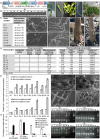Foot rot tolerant transgenic rough lemon rootstock developed through expression of β-1,3-glucanase from Trichoderma spp
- PMID: 31087505
- PMCID: PMC6790366
- DOI: 10.1111/pbi.13152
Foot rot tolerant transgenic rough lemon rootstock developed through expression of β-1,3-glucanase from Trichoderma spp
Keywords: Phytophthora parasitica; hyphal structural degradation; scanning electron microscopy; transgenic rootstock.
Figures

References
-
- Bartnicki‐Garcia, S. (1966) Chemistry of hyphal walls of Phytophthora . J. Gen. Microbiol. 42, 57–69. - PubMed
-
- Benítez, T. , Rincón, A.M. , Limón, M.C. and Codón, A.C. (2004) Biocontrol mechanisms of Trichoderma strains. Int. Microbiol. 7, 249–260. - PubMed
-
- van den Berg, N. , Christie, J.B. , Aveling, T.A.S. and Engelbrecht, J. (2018) Callose and β‐1,3‐glucanase inhibit Phytophthora cinnamomi in a resistant avocado rootstock. Plant. Pathol. 67, 1150–1160.
-
- Castle, W.S. (2010) A career perspective on citrus rootstocks, their development and commercialization. HortScience, 45, 11–15.
Publication types
MeSH terms
Substances
LinkOut - more resources
Full Text Sources
Miscellaneous

